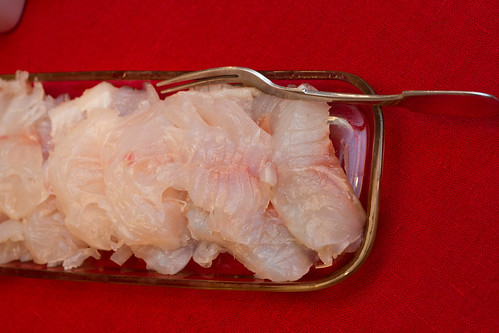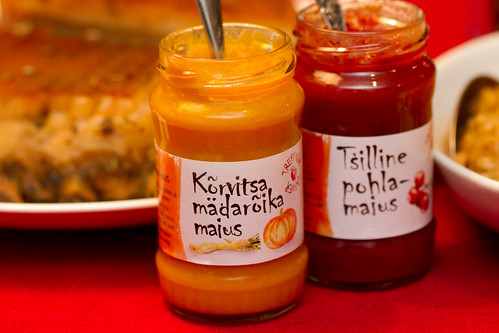
Good black Estonian bread, some white toast and a selection of cured fish. Starting from the left, there are spiced Baltic sprats that I wrote about in the previous post (see here), but this time served simply with sliced red onion:

Then there's salt-cured whitefish from my favourite fishmonger, PepeKala OÜ. Whitefish slices are to be eaten with buttered toast:

Finally, locally grown and jellied catfish (African sharptooth catfish, to be more precise, angersäga in Estonian, Clarias gariepinus in Latin). This one came out of the jar as well :)

For those who prefer meat, I did serve some cold-smoked turkey slices:

Serving a selection of cured fish for starters is a rather Nordic thing to do, but you'd find many more dishes on a traditional Estonian Christmas table (some rosolje salad or perhaps the layered vegetable salad). But we kept it rather minimalist this year and it worked for us.
The main course was much more traditional. There was pork - but not my usual Christmas roast, the ever-delicious oven-baked pork shoulder with honey, mustard and rosemary. I did experiment with pork belly and fennel seeds - and rather successfully - the meat was extremely succulent and melt-in-your-mouth, and gobbled up quickly.

Here's a close-up of the pork:

The cabbage was my classic õllekapsas aka sauerkraut braised in beer (the beer was A le Coq's porter):

There were simple boiled potatoes, and a duo of roasted veggies - carrots and parsnips, lightly drizzled with maple syrup:

The duo of roasted vegetables was accompanied by a trio of black pudding:

For condiments, there were two relishes from a small Estonian producer, Treppoja. Pumpkin and horseradish (the yellow one) and chilli and lingonberry (the red one):

Neither one was bad, but my mother-in-law's apple and lingonberry jam came out tops (I've got a recipe here, but she uses more lingonberries and less apples):

The star of the evening, as usual, was the dessert. I was planning to do the popular Danish Christmas dessert risalamande or fluffy rice pudding with almonds and a warm cherry compote. But then our little family went to Denmark for a small holiday in early December, and my dear Danish host-mum Kirsten served us a wonderful æbletrifli - a layered trifle of æblegrød, whipped cream and custard, as well as crunchy Italian almond cookies. It was simple, delicious and really festive, so that ended up finishing our Christmas feast of 2013.

We didn't drink much - some beers, and some small glasses of the Swedish Blossa glögg from 2012 and 2013, juice and water for the kids..
What did you do for Christmas?
See all Nami-Nami's Christmas recipe here.
Estonian World writes about Estonian Christmas traditions here.








